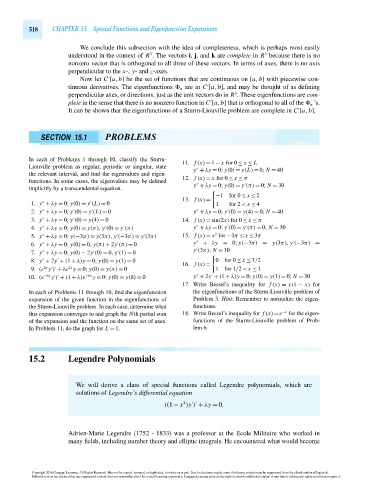Page 538 - Advanced_Engineering_Mathematics o'neil
P. 538
518 CHAPTER 15 Special Functions and Eigenfunction Expansions
We conclude this subsection with the idea of completeness, which is perhaps most easily
3
3
understood in the context of R . The vectors i, j, and k are complete in R because there is no
nonzero vector that is orthogonal to all three of these vectors. In terms of axes, there is no axis
perpendicular to the x-, y- and z-axes.
Now let C [a,b] be the set of functions that are continuous on [a,b] with piecewise con-
tinuous derivatives. The eigenfunctions n are in C [a,b], and may be thought of as defining
3
perpendicular axes, or directions, just as the unit vectors do in R . These eigenfunctions are com-
plete in the sense that there is no nonzero function in C [a,b] that is orthogonal to all of the n ’s.
It can be shown that the eigenfunctions of a Sturm-Liouville problem are complete in C [a,b].
SECTION 15.1 PROBLEMS
In each of Problems 1 through 10, classify the Sturm-
11. f (x) = 1 − x for 0 ≤ x ≤ L
Liouville problem as regular, periodic or singular, state
y + λy = 0; y(0) = y(L) = 0; N = 40
the relevant interval, and find the eigenvalues and eigen-
12. f (x) = x for 0 ≤ x ≤ π
functions. In some cases, the eigenvalues may be defined
implicitly by a transcendental equation. y + λy = 0; y(0) = y (π) = 0; N = 30
−1for 0 ≤ x ≤ 2
13. f (x) =
1. y + λy = 0; y(0) = y (L) = 0 1 for 2 < x ≤ 4
2. y + λy = 0; y (0) = y (L) = 0 y + λy = 0; y (0) = y(4) = 0; N = 40
3. y + λy = 0; y (0) = y(4) = 0 14. f (x) = sin(2x) for 0 ≤ x ≤ π
4. y + λy = 0; y(0) = y(π), y (0) = y (π) y + λy = 0; y (0) = y (π) = 0; N = 30
2
5. y + λy = 0; y(−3π) = y(3π), y (−3π) = y (3π) 15. f (x) = x for −3π ≤ x ≤ 3π
6. y + λy = 0; y(0) = 0, y(π) + 2y (π) = 0 y + λy = 0; y(−3π) = y(3π), y (−3π) =
y (3π); N = 10
7. y + λy = 0; y(0) − 2y (0) = 0, y (1) = 0
8. y + 2y + (1 + λ)y = 0; y(0) = y(1) = 0 0for 0 ≤ x ≤ 1/2
16. f (x) =
2x
2x
9. (e y ) + λe y = 0; y(0) = y(π) = 0 1for 1/2 < x ≤ 1
10. (e −6x y ) + (1 + λ)e −6x y = 0; y(0) = y(8) = 0 y + 2y + (1 + λ)y = 0; y(0) = y(1) = 0; N = 30
17. Write Bessel’s inequality for f (x) = x(4 − x) for
In each of Problems 11 through 16, find the eigenfunction the eigenfunctions of the Sturm-Liouville problem of
expansion of the given function in the eigenfunctions of Problem 3. Hint: Remember to normalize the eigen-
the Sturm-Liouville problem. In each case, determine what functions.
this expansion converges to and graph the Nth partial sum 18. Write Bessel’s inequality for f (x)=e −x for the eigen-
of the expansion and the function on the same set of axes. functions of the Sturm-Liouville problem of Prob-
In Problem 11, do the graph for L = 1. lem 6.
15.2 Legendre Polynomials
We will derive a class of special functions called Legendre polynomials, which are
solutions of Legendre’s differential equation
2
((1 − x )y ) + λy = 0.
Adrien-Marie Legendre (1752 - 1833) was a professor at the Ecole Militaire who worked in
many fields, including number theory and elliptic integrals. He encountered what would become
Copyright 2010 Cengage Learning. All Rights Reserved. May not be copied, scanned, or duplicated, in whole or in part. Due to electronic rights, some third party content may be suppressed from the eBook and/or eChapter(s).
Editorial review has deemed that any suppressed content does not materially affect the overall learning experience. Cengage Learning reserves the right to remove additional content at any time if subsequent rights restrictions require it.
October 14, 2010 15:20 THM/NEIL Page-518 27410_15_ch15_p505-562

